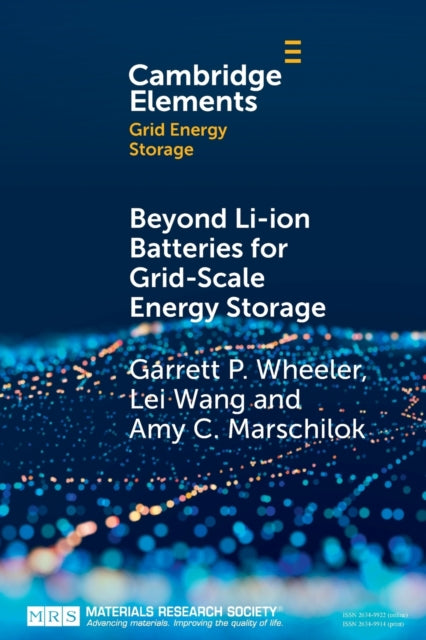Garrett P.Wheeler,LeiWang,Amy C. Marschilok
Beyond Li-ion Batteries for Grid-Scale Energy Storage
Beyond Li-ion Batteries for Grid-Scale Energy Storage
YOU SAVE £0.86
- Condition: Brand new
- UK Delivery times: Usually arrives within 2 - 3 working days
- UK Shipping: Fee starts at £2.39. Subject to product weight & dimension
Bulk ordering. Want 15 or more copies? Get a personalised quote and bigger discounts. Learn more about bulk orders.
Couldn't load pickup availability
- More about Beyond Li-ion Batteries for Grid-Scale Energy Storage
Battery systems are essential for improving the resiliency of the grid and integrating renewable energy sources. Other battery technologies, such as Li-ion, are being explored to expand the breadth and depth of battery storage system installations. This Element discusses existing technologies beyond Li-ion battery storage chemistries and analyzes their chemistry mechanisms, battery construction and design, and corresponding advantages and disadvantages.
Format: Paperback / softback
Length: 75 pages
Publication date: 07 July 2022
Publisher: Cambridge University Press
The utilization of battery systems to store energy for later demand is of paramount importance in enhancing the resilience of the grid and enabling the integration of renewable energy sources into the grid. The implementation of grid-scale electrical energy storage systems can provide numerous benefits, including peak shaving and load leveling, voltage and frequency regulation, and emergency power supply. While the predominant battery chemistry currently used is lithium-ion due to factors such as cost, safety, and sourcing concerns, there is interest in incorporating other battery technologies to expand the breadth and depth of battery storage system installations.
This Element explores existing technologies beyond lithium-ion battery storage chemistries that have been deployed at grid scale, as well as several other promising battery technologies. It provides an in-depth analysis of their chemistry mechanisms, battery construction and design, and corresponding advantages and disadvantages.
One promising battery technology is sodium-ion battery (SIB), which has gained significant attention in recent years due to its high energy density, low cost, and non-flammable nature. SIBs are typically constructed using a cathode material such as nickel, manganese, or cobalt, and an anode material such as graphite or silicon. The electrolyte used in SIBs is typically a lithium-ion-based solution, which allows for high energy storage capacity and fast charging times.
Another promising battery technology is flow battery, which uses a liquid electrolyte to store energy. Flow batteries have the advantage of being able to store large amounts of energy and providing long-duration storage. However, they are currently more expensive than other battery technologies and require specialized infrastructure for their operation.
In addition to these battery technologies, there are several other promising battery technologies that are currently under development, such as solid-state batteries, lithium-metal batteries, and sodium-metal batteries. These technologies have the potential to revolutionize the energy storage industry by providing higher energy densities, longer lifetimes, and more stable performance.
However, the implementation of these battery technologies also presents several challenges, including the need for improved battery materials, efficient energy storage systems, and robust regulatory frameworks. To address these challenges, researchers and industry stakeholders are working tirelessly to develop new technologies and improve existing ones.
In conclusion, the utilization of battery systems to store energy for later demand is of paramount importance in enhancing the resilience of the grid and enabling the integration of renewable energy sources into the grid. The implementation of grid-scale electrical energy storage systems can provide numerous benefits, including peak shaving and load leveling, voltage and frequency regulation, and emergency power supply. While the predominant battery chemistry currently used is lithium-ion, there is interest in incorporating other battery technologies to expand the breadth and depth of battery storage system installations.
This Element explores existing technologies beyond lithium-ion battery storage chemistries that have been deployed at grid scale, as well as several other promising battery technologies. It provides an in-depth analysis of their chemistry mechanisms, battery construction and design, and corresponding advantages and disadvantages. With continued research and development, it is likely that these battery technologies will play an increasingly important role in the future of energy storage and renewable energy integration.
Weight: 157g
ISBN-13: 9781009015707
This item can be found in:
UK and International shipping information
UK and International shipping information
UK Delivery and returns information:
- Delivery within 2 - 3 days when ordering in the UK.
- Shipping fee for UK customers from £2.39. Fully tracked shipping service available.
- Returns policy: Return within 30 days of receipt for full refund.
International deliveries:
Shulph Ink now ships to Australia, Belgium, Canada, France, Germany, Ireland, Italy, India, Luxembourg Saudi Arabia, Singapore, Spain, Netherlands, New Zealand, United Arab Emirates, United States of America.
- Delivery times: within 5 - 10 days for international orders.
- Shipping fee: charges vary for overseas orders. Only tracked services are available for most international orders. Some countries have untracked shipping options.
- Customs charges: If ordering to addresses outside the United Kingdom, you may or may not incur additional customs and duties fees during local delivery.


